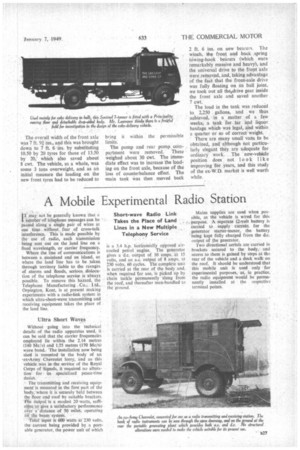A Mobile Experimental Radio Station
Page 53

If you've noticed an error in this article please click here to report it so we can fix it.
Short-wave Radio Link Takes the Place of Land Lines in a New Multiple Telephony Service IT may not be generally known that a I. nttmber of telephone messages can be passed along a single pair of wires at one time. without fear of cross-talk interference. This is made possible by the use of radio, each transmission being sent out on the land line on a fixed wavelength, or carrier frequency.
Where the line of communications is between a mainland and an island, or where the land line has to be taken, through territory liable to the ravages of storms and floods, serious dislocation of the telephone service is always possible. To remove this hazard, the Telephone Manufacturing Co.,, Ltd., . Orpington, Kent, is at present making experiments with a radio-link system in which ultra-short-wave transmitting and receiving equipment takes the place of the land line.
Ultra Short Waves Without going into the technical details of the radio apparatus used, it can be said that the carrier frequencies employed lie within the 2.14 metres (140 Mr/s) and 1.75 metres (170 Mc/s) wave band. The installation now being used is mounted in the body of an .evArmy Chevrolet lorry, and as this vehicle was in the serVice of the Royal Corps of Signals, it required no alteration for • its specialized peace-time duties.
' The transmitting and receiving equipment is mounted in the fore part of the body, where it is seeurely'held between the floor and roof by suitable brackets. The output is a modest 20 watts, sufficient:to give a satisfactory performance over a•distance of 50 ntilel, operating the 'beam system. • Total inputis 600 watts at 230 volts. the current being provided by a portable generator, the power unit of which
is a 3.4 h.p. horizontally opposed aircooled petrol engine. The generator gives a d.c. output of 10 amps. at 15 volts, and an a.c. output of 8 amps. at 230 volts, 60 cycles. The complete unit is carried at the rear of the body and. when required 'for use, is picked up by chain tackle permanently slung from the roof, and thereafter man-handled to the ground. Mains supplies are used when possible, as the vehicle is wired for this purpose. A separate 12-volt battery is carried to supply current for the generator starter-motor, the battery being kept fully charged from the d.c. output of the generator. Two directional aerials are carried in brackets secured to the body, and access to them is gained by steps at thz rear of the vehicle and a duck walk on the roof. It should be understood that this mobile unit is used only for experimental purposes, as, in practice. the radio equipment would be permanently installed at the respective terminal points.




















































































